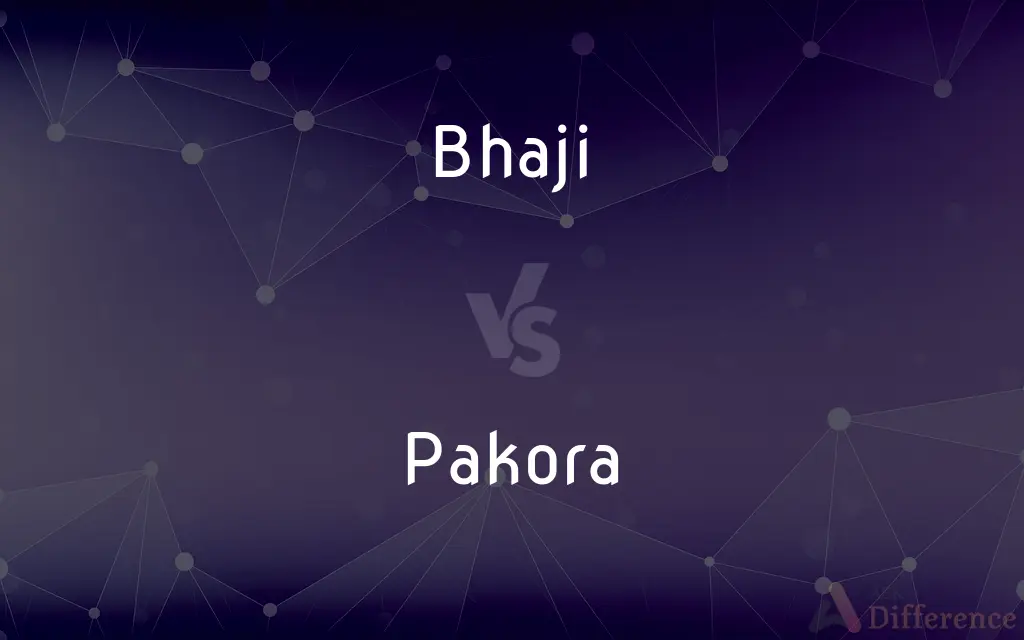Bhaji vs. Pakora — What's the Difference?
By Tayyaba Rehman & Maham Liaqat — Updated on March 4, 2024
Bhaji and pakora are both popular Indian snacks made by deep-frying, but bhajis are often onion-based, while pakoras can include a variety of vegetables or meats.

Difference Between Bhaji and Pakora
Table of Contents
ADVERTISEMENT
Key Differences
Bhaji, in the context of Indian cuisine, typically refers to a type of fritter made primarily with onion slices coated in a seasoned gram flour (chickpea flour) batter and deep-fried until golden. The term is most famously associated with "onion bhaji," a staple appetizer in Indian restaurants worldwide. Pakora, on the other hand, represents a broader category of Indian fritters that can be made from a wide range of ingredients, including vegetables like potatoes, spinach, cauliflower, and paneer (Indian cottage cheese), as well as meats in some regional variations. Like bhajis, pakoras are coated in a spiced gram flour batter and deep-fried.
Bhajis focus on the mild, sweet flavor of the onions, enhanced by spices like turmeric, chili powder, and sometimes carom seeds, offering a crispy exterior with a soft, savory interior. The choice of spices in the batter of pakora can vary widely, incorporating garam masala, fenugreek leaves, and ajwain, among others, resulting in a crispy and flavorful snack.
The main distinction lies in their ingredients and, to some extent, regional preferences. Bhaji has come to be closely associated with onion fritters in many places, whereas pakora encompasses a wider variety of ingredients. Both snacks are served with chutneys or sauces, such as mint or tamarind chutney, enhancing their flavors.
The terms bhaji and pakora might be used interchangeably, reflecting local linguistic preferences. However, in international cuisine, the distinction often holds, with bhaji being synonymous with onion fritters and pakora referring to a more diverse range of fried snacks.
Both bhajis and pakoras are integral to Indian snack cuisine, enjoyed at various occasions, from everyday tea times to grand celebrations and festivals. They exemplify the rich tradition of Indian deep-fried foods, offering a blend of textures and flavors that have gained popularity worldwide.
ADVERTISEMENT
Comparison Chart
Primary Ingredient
Onion (typically)
Variety of vegetables, paneer, and meats
Batter
Gram flour with spices
Gram flour with a wider range of spices
Texture
Crispy outside, soft inside
Uniformly crispy
Regional Preference
Commonly associated with Maharashtra and South India
Popular across India
Serving Occasions
Snacks, appetizers
Snacks, appetizers, part of a meal
Varieties
Mainly onion-based
Includes vegetables, paneer, and meats
Compare with Definitions
Bhaji
Onion-based fritter.
Onion bhaji is a popular appetizer in Indian cuisine.
Pakora
Spiced gram flour batter.
The pakora batter is richly spiced for flavor.
Bhaji
Made with gram flour.
Bhajis are dipped in a seasoned gram flour batter before frying.
Pakora
Across India.
Pakoras are enjoyed in every region of India with regional variations.
Bhaji
Served with chutney.
Onion bhajis are often served with mint or tamarind chutney.
Pakora
Diverse fritters.
Pakoras can be made with vegetables, paneer, or meats.
Bhaji
Street food favorite.
Bhajis are a common street food in various parts of India.
Pakora
Versatile snack.
Pakoras are a versatile snack, enjoyed with tea or as an appetizer.
Bhaji
Crispy and savory.
Bhajis offer a crispy exterior with a soft onion center.
Pakora
Accompanied by chutneys.
Pakoras are typically served with a selection of chutneys.
Bhaji
A bhaji, also known as Onion Bhaji (British English), is an Indian appetiser that is made from spicy hot vegetable, sometimes fried similar to a fritter, originating from the Indian subcontinent, with several variants. It is a popular snack food in Kerala, Tamil Nadu, Goa, Maharashtra, Gujarat, Andhra Pradesh, Telangana, Karnataka, Assam, West Bengal and Odisha in India, it is also very popular in Pakistan and Trinidad and Tobago and can be found for sale in street-side stalls, especially in tapris (Marathi: टपरी) (on streets) and dhabas (Punjabi: ਢਾਬਾ) (on highways).
Pakora
Pakora (pronounced [pəˈkɔːɽa]) is a spiced fritter originating from the Indian subcontinent, sold by street vendors and served in restaurants in South Asia and worldwide. It consists of items, often vegetables such as potatoes and onions, coated in seasoned gram flour batter and deep fried.
Bhaji
Any of various Indian dishes of fried vegetables
Onion bhaji
Pakora
A deep-fried fritter made of vegetables or meat dipped in a chickpea batter, served as an appetizer or a snack in South Asian cuisine.
Pakora
A piece of vegetable, or sometimes meat, deep-fried in a batter flavoured with spices.
Common Curiosities
Can the term bhaji refer to other vegetables besides onion?
While commonly associated with onions, bhaji can also refer to other vegetable fritters in some regional Indian cuisines.
Is there a preferred time to enjoy bhajis and pakoras?
They are popular as snacks or appetizers and are particularly favored during monsoon and cold weather.
What are common spices used in bhaji and pakora batters?
Common spices include turmeric, chili powder, garam masala, and ajwain, among others.
How are bhajis and pakoras served?
Both are usually served hot with chutneys or sauces, such as mint, tamarind, or yogurt-based dips.
Can bhajis and pakoras be found outside of India?
Yes, the popularity of Indian cuisine globally has made bhajis and pakoras widely available in many countries.
What makes bhaji different from pakora?
Bhaji usually refers to onion fritters, while pakora can be made from a wider variety of ingredients.
Are pakoras always vegetarian?
While often vegetarian, pakoras can also include meats in certain regional variations.
Can bhajis and pakoras be made in a healthier way?
For a healthier option, they can be baked or air-fried, though this might alter their traditional texture.
Do bhajis and pakoras have regional names?
Yes, both snacks may be known by different names or variations across India's diverse regions.
What is the significance of these snacks in Indian cuisine?
Bhajis and pakoras are not just snacks but an integral part of Indian culinary tradition, reflecting the diversity and richness of Indian food culture.
Share Your Discovery

Previous Comparison
Edition vs. Issue
Next Comparison
Feedeth vs. HeedethAuthor Spotlight
Written by
Tayyaba RehmanTayyaba Rehman is a distinguished writer, currently serving as a primary contributor to askdifference.com. As a researcher in semantics and etymology, Tayyaba's passion for the complexity of languages and their distinctions has found a perfect home on the platform. Tayyaba delves into the intricacies of language, distinguishing between commonly confused words and phrases, thereby providing clarity for readers worldwide.
Co-written by
Maham Liaqat















































